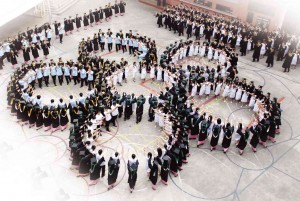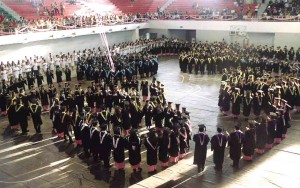White flower, not pink, for cherished tradition at CEU
Since 1938, every graduating student of the 105-year-old Centro Escolar University (CEU) has been taking part in a unique formation symbolizing the Philippines’ national flower.
At the traditional Sampaguita Interlude, graduating students pass on the torch of responsibility to the incoming seniors.
For Class 2013, this year’s Sampaguita Interlude, the 31st to be staged on the CEU Malolos campus, was held four days before the university’s graduation rites.
Dr. Juliana Alvaro, CEU Malolos vice president, explained why the annual ritual was named after the sampaguita (Jasminum sambac).
She said the flower, a member of the jasmine family, symbolized the ideal Filipino and the ideal Escolarian.
Article continues after this advertisement“CEU students are modest, like the spotless whiteness of the sampaguita petals; loyal and sincere, like the flower’s lingering sweetness and its fragrance; firm and courageous, like its green stalks and sturdy sepals,” Alvaro said.
Article continues after this advertisementThe event was a highly anticipated prelude to the university’s commencement exercises. Clad in togas, some 300 graduating students swayed gracefully as they sang “Fair Sampaguita,” “El Collar Sampaguita” and “Sampaguitang Mabango.”
Magna cum laude graduates Jarkie Miranda (Bachelor of Arts in Mass Communication-Broadcast), Mae Belle Cruz and Princess Lovely Arcenal (Bachelor of Science in Tourism Management) were teary-eyed as they led their respective groups in forming the shape of the national flower.
Elvira Borlongan, head of the Malolos campus marketing and communication department, said the tradition began as an all-female performance. It had since evolved to include male

ON THE CEU Mendiola campus, the national flower is depicted in this five-circle formation. PHOTO COURTESY OF CEU
graduates.
CEU, originally called Centro Escolar de Señoritas, was founded as a normal (teacher training) school for women on June 3, 1907, by educators Librada Avelino and Carmen de Luna.
From a rented house in Sampaloc, close to the commercial districts of Quiapo and Santa Cruz in Manila, the school moved to Mendiola Street in 1924 to accommodate a growing school population.
It became a university in 1933. CEU now has five campuses: In Manila, on Mendiola Street (main campus); in Malolos, on MacArthur Highway; in Makati, on Gil Puyat Avenue and Legazpi Village, in the heart of the city’s central business district; and in Cebu City, on Osmeña Boulevard, the first facility outside Luzon.
The university has plans of putting up new campuses in the cities of Baguio and Davao.
